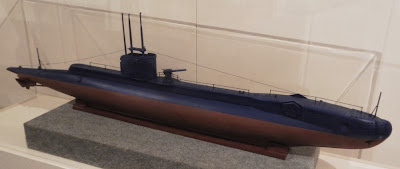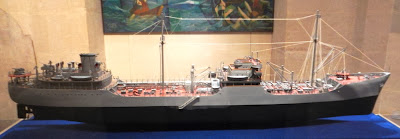The histories of the Royal Navy and Malta were intertwined from the moment the British took possession of the islands in 1800 until the country gained independence in 1964… and even for a few years afterwards! It is therefore not surprising that a large part of the Naval Museum in Malta is dedicated to the Royal Navy.
When the first Royal Navy ships were stationed on Malta, they were all wooden sailing ships, and the Museum has a magnificent example of a ship’s figurehead …
… as well as a reconstruction of part of a gun deck.
It also has a model of HMS Vanguard, a 74 gun ship-of-the-line that served as Admiral Nelson’s flagship during the blockade of French-occupied Malta.
The development of early steam warships is also covered, and the display includes a model of HMS Arethusa.
There is also a massive display of 1:1200th-scale ships that show the development of Royal Navy ship design from 1800 until 2000.
A small section of the Museum has been set aside as a display area devoted to one of the worst peacetime tragedies suffered by the Royal Navy during the Victorian era, the sinking of HMS Victoria after she had been accidentally rammed by HMS Camperdown.
The Royal Navy always tried to ensure that its sailors were well-trained and fit and a lot of time and effort went into ensuring that they were. Wet and dry canteens were provided (‘wet’ canteens served beer and ‘dry’ canteens served tea) …
… and sports such as sailing …
… and rowing were actively encouraged.
Hobbies were also popular, and making models of ships was very common.
Diring World War II Malta played a key role in keeping the supply lines open from the UK to Middle East and this is illustrated by a number of exhibits. These include examples of unexploded German torpedoes, …
… a model of a typical submarine that operated out of Malta against Italian and German ships sailing in the Mediterranean, …
… and numerous models of warships that operated during the war. These include HMS Hood (which was a frequent visitor to Malta between the wars), …
… HMS King George V, …
… HMS Mowhawk, …
… and a Javelin-class Destroyer.
Pride of place is given to a model of the Ohio, a tanker which was seriously damaged and yet still managed to get through the German and Italian blockade of Malta in order to deliver much needed supplies.
The post-war Royal Navy is represented by a number of model warships including HMS Dainty, …
… HMS Andromeda, …
… HMS Avenger, …
… and HMS Onslaught.
One very curious object in this Hall was a Mercury Arc Rectifier.
This was used in the Royal Dockyard to convert alternating electric current into direct electrical current … and vice versa.
When the first Royal Navy ships were stationed on Malta, they were all wooden sailing ships, and the Museum has a magnificent example of a ship’s figurehead …
… as well as a reconstruction of part of a gun deck.
It also has a model of HMS Vanguard, a 74 gun ship-of-the-line that served as Admiral Nelson’s flagship during the blockade of French-occupied Malta.
The development of early steam warships is also covered, and the display includes a model of HMS Arethusa.
There is also a massive display of 1:1200th-scale ships that show the development of Royal Navy ship design from 1800 until 2000.
A small section of the Museum has been set aside as a display area devoted to one of the worst peacetime tragedies suffered by the Royal Navy during the Victorian era, the sinking of HMS Victoria after she had been accidentally rammed by HMS Camperdown.
The Royal Navy always tried to ensure that its sailors were well-trained and fit and a lot of time and effort went into ensuring that they were. Wet and dry canteens were provided (‘wet’ canteens served beer and ‘dry’ canteens served tea) …
… and sports such as sailing …
… and rowing were actively encouraged.
Hobbies were also popular, and making models of ships was very common.
Diring World War II Malta played a key role in keeping the supply lines open from the UK to Middle East and this is illustrated by a number of exhibits. These include examples of unexploded German torpedoes, …
… a model of a typical submarine that operated out of Malta against Italian and German ships sailing in the Mediterranean, …
… and numerous models of warships that operated during the war. These include HMS Hood (which was a frequent visitor to Malta between the wars), …
… HMS King George V, …
… HMS Mowhawk, …
… and a Javelin-class Destroyer.
Pride of place is given to a model of the Ohio, a tanker which was seriously damaged and yet still managed to get through the German and Italian blockade of Malta in order to deliver much needed supplies.
The post-war Royal Navy is represented by a number of model warships including HMS Dainty, …
… HMS Andromeda, …
… HMS Avenger, …
… and HMS Onslaught.
One very curious object in this Hall was a Mercury Arc Rectifier.
This was used in the Royal Dockyard to convert alternating electric current into direct electrical current … and vice versa.














































0 Yorumlar